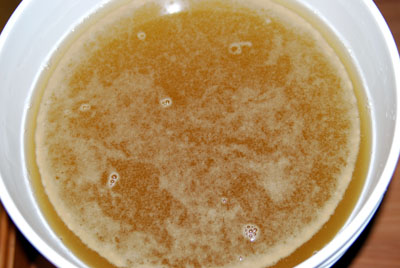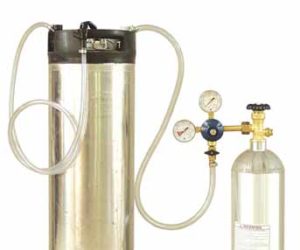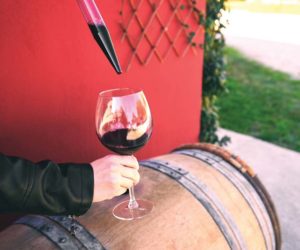Q
I recently made a batch of banana spice wine and followed the directions accordingly. Now that it is done the clove is so overpowering that it is not good. Is there anything I can add to settle it down or should I just throw it away and start over?
Joseph Whyers
Odin, Illinois
A
There’s nothing like a wine with what I call “the elbows sticking out” to ruin one’s mood. Especially frustrating is when one has followed a recipe or kit instructions to the letter only to find that the procedure has yielded less than satisfying results. Spices and other added flavorings in home winemaking are one of the trickiest things to get right. Commercial winemakers also struggle with this issue as anyone disappointed over a lot of over-oaked Chardonnay can attest. “Flavor enhancers” (and I’ll include oak barrels in this as well as oak pieces) are so tough because once your wine has soaked in its new barrel (or with its little bag of cloves and cinnamon stick) for too long, these pesky aromatics are almost impossible to remove.
Unfortunately, this is the case for your banana wine. The strong clove aroma can only be toned down by blending back with more wine. There is no fining agent or simple filtration process that will materially change the aroma. Unlike protein or tannin molecules (which can both be fined out with bentonite and protein, respectively), aroma compounds are so teeny tiny that only very expensive (and industrial scale) nanofiltration technology can begin to remove specific aroma compounds. Some large commercial wineries have been successful at removing the aromas that contribute to cork taint and smoke taint. Though this technology continues to develop all the time, the industry will likely focus its efforts on aromas most of concern to wineries, especially TCA, Brettanomyces off-odors, pyrazines (green bell pepper aroma from unripe grapes), smoke taint and the like. Since table wine producers aren’t allowed to add spices like cloves or cinnamon or other flavorings like vanilla, (only the naturally-occurring aromas from grapes and from oak aging are allowed) I’m not anticipating any special clove-removal filtration being developed soon.
But back to the easiest thing you can do to try to ameliorate your wine back to a happy point of drinkability: back blending. Ideally, you would make an identical batch of banana wine, this time omitting the clove addition, and then dosing in the non-cloved wine with the spiced-up batch until you found an aroma balance that you liked. If this is not possible, don’t forget home winemakers always have the luxury of creative blending ideas such as blending with another batch entirely, trading some gallons with a friend to blend, or even (though I know some of you are opposed to this) buying some bottles of wine off the shelf (maybe an un-oaked Chardonnay would be appropriate here) and adding that material to your batch to cut down on the clove character.
As to how to prevent this kind of thing happening to you in the future, my biggest piece of global advice is to always take a “flavoring agent” recommendation in a wine or kit protocol with a grain of salt. Like salt is to food, what is written in the recipe might not be to your taste and you might want more or less of it. Additives like spices, extracts or essences often aren’t chemically or physiologically critical for the overall stability and soundness of a wine. A banana wine will still be a banana wine with 1 tsp. of cloves per batch or two. The latter will simply have more clove character and it might not be pleasant to you. The recipe elements that are critical, however, and which shouldn’t be messed with lightly include anything containing sugar, acid, water or yeast nutrients. Those form the foundation of the wine and will materially affect alcohol level and fermentation completeness. Things like tannin and fining agent additions start to enter a grey area but still should be followed close to the letter of the recipe. Additives like oak pieces, orange peel, ginger root and other spices are only there for aroma and flavor and in my mind can (and should) be employed according to individual taste.
But how can you know how much of an aromatic to add when you’ve never made the recipe before? Start small and work your way up. Cut the amount in half, add that and see how you like it. You can always add more. Or let your cheesecloth bag with the cinnamon stick and star anise only infuse in your carboy overnight and see how you like it before letting it steep for the week recommended in the recipe.
This type of step-wise adding is a very simple way of doing what I call “bench trials on the fly.” A proper bench trial is done “on the lab bench” and involves testing small, measured amounts of any additive (be it a blending wine, a fining agent or a spice) in a measured amount of wine, typically 50–100 mLs, letting the additive react and then smelling and tasting the results. It’s really the best way to treat a sample before inflicting a possibly unknown (and possibly damaging) process or additive to your whole batch. Additionally, I know many home winemakers just don’t have the micro-measuring equipment necessary (Eppendorf pipettes and accurate digital scales are very expensive!), so often this step-wise addition process is an easy-to-do compromise.
Q
What are your thoughts about fining reds? If you recommend it, what type of agents are best (and most available to a home winemaker ). Also, I make blends on occasion and wonder if I should blend at crushing or after aging.
Frank Scafide
Cleveland, Ohio
A
Red wines are typically not fined as often as white wines, to which we often add bentonite in order to remove potentially haze-causing proteins. The tannin from the skins of red wines tends to bind with excess protein, the agglomeration of which will precipitate out during the fermentation process. Nor do we usually cold-stabilize red wines, where cold storage (often 32–35 °F/0–2 °C for a few days) and a potassium bitartrate addition precipitate excess tartrate crystals from the wine, which can look like glass shards. The bottom line is that, visually at least, red wines just hide a lot of instabilities much better than white wines and so especially for small lot producers whose wines are not widely distributed (which includes home winemakers), many of us just don’t bother with fining our reds at all. Longer storage in barrel before bottling does a lot of the work for us; we let time and gravity work their magic. Many of us tend to simply rack our red wines off the well-settled lees before bottling and call it a vintage.
However there are absolutely some instances in which fining reds can make a lot of sense. Excessive tannins, especially in varietals like Cabernet Sauvignon, Malbec, Cabernet Franc, Tannat and Petit Verdot, can be removed by adding a protein like egg whites or casein (milk protein). The added protein (the limiting reagent) will bind with available tannin until exhausted at which point the protein+tannin molecule, now with a much larger molecular weight, will come out of solution and fall to the bottom of the aging vessel as a solid. With time and gravity (and some luck, of course), this material will compact into a nice, solid lees layer from which a much clearer and less-tannic wine can be racked. Each wine will vary, but I usually allow for three weeks at the very least for a quick settle but prefer six weeks for a nice, solid settling. Adding protein to extracted, astringent wines can really help smooth out the rough edges and create a red with a rounder, more “generous” mouthfeel, in addition to creating a more visually clear (less cloudy) final product. A protein fining can make a wine ready to drink a little sooner and can even cut down on the amount of bottle aging needed to tame aggressive tannins.
Sometimes you may want to just worry about clarification of your red wines and want cloudiness to settle out. Bentonite can help here, if you happen to have some on hand, but adding egg whites or other protein finings will also help clarify. Bitterness can be helped by a bentonite and casein blend like “Bentolact S.” Astringency can often be helped by gelatins, in addition to other protein finings. If you want to avoid animal-protein (egg, casein, gelatin, isinglass) fining agents altogether, you might want to try some suspended silica preparations with vegan Alginic acid (aka alginates) sourced from algae, which does a good job of pulling out excess tannins and clarifying. Though I haven’t seen any study where someone can detect residual egg whites or milk protein in finished, fined wine (because the proteins bind with tannins and other compounds and come out of solution, then they are removed from the wine), some people choose not to use any animal-based items in their winemaking.
Though they are not exactly traditional “fining agents,” an exciting new class of mouthfeel and texture enhancers for red wines many winemakers are experimenting with are what I call “finishing tannins” but may also be called “polymerized aging tannins” in the literature. Paradoxically, sometimes adding tannin to tannin can actually enhance mouthfeel and perceived quality of red wines. They won’t help with clarity and often won’t help mask bitterness, but can give you some positive interactions. Check with your winemaking supply purveyor of choice, and also check out aebusa.com, scottlab.com and americantartaric.com for ideas of tannins to try.
For many small-lot winemakers, the classic protein for red wine fining is egg white. It’s cheap, and it is easy for everyone to find. Remember — the more egg white you add, the more tannin the protein will pull out of solution. A not-so-tannic wine that needs just a teeny bit of smoothing out probably will do well at a dose of 0.40 mLs egg white/gallon wine but a very tannic wine might need 2 mLs/gallon or even more. If you have the patience (and the ability to measure out really small volumes) try doing a bench trial on 100 mL of wine or so first, to see what you prefer.
Be forewarned; you can always add more egg if you want to pull out more tannin, but it’s tougher to put tannin back once you’ve over-fined (or stripped) your wine. Figure that your average American egg will have around 24 mL of egg white per shell. Sometimes winemakers talk about “adding one egg per barrel,” so if you use those “units,” figure that’s 24 mLs of egg white (the white yield from one egg)/59 gallons, or 0.4 mLs/gallon. I find for softer wines 0.4 mLs/gallon is great, but often I go up to 2 mLs egg white/gallon for something big and tannic.
Here is how you would employ the egg whites you do decide to use for your own batch:
1. Break your egg(s) and carefully separate the white from the yolk.
2. Measure out the number of mLs of egg white you want to use in a graduated cylinder or with a pipette and place in a small bowl.
3. Add a tiny pinch of table salt and enough water (a few mL or a little more, as needed) to make a liquid solution.
4. With a whisk or a fork, gently dissolve the egg white into the water. Do not beat too much air into the solution.
5. Dump the entire solution into your vessel and stir gently with a long stirring rod for about 30 seconds or so to make sure the liquid is distributed.
6. Leave covered (if you have headspace, gassing with CO2 or argon is always a good idea after you open a vessel) for at least three weeks to settle out.
7. Rack the wine carefully into another container, leaving any sediment on the bottom of the original container.
To answer your last question, I always recommend cross-blending varietals and lots after at least six months of aging separately, so you know what your components will give you and they’ve had a chance to “settle down” after fermentation. That being said, you want to allow enough “marrying” time before bottling to account for any instabilities that might crop up. It’s a new chemical soup after all.
Q
I picked up Sauvignon Blanc grapes late in the day that they were harvested. I let them sit overnight and began crushing/destemming early the next morning. The free run juice was brown in color, not the pale green color of the commercial SB’s I buy. This wine is nearly completed fermentation now and although it tastes fine it has retained the brown color. Will sterile filtering give me the nice clear pale green color I am seeking?
Leonard Zacher
Kelseyville, California
A
Sorry to say, but it sounds like you’ve got a no-bueno situation. White grapes should always be pressed as soon as possible after picking in order to reduce juice (and subsequent wine) browning. By letting your white grapes sit overnight (and they’re juicy after being picked, especially at the lower levels of your buckets or bins) you started what effectively was a whole-cluster maceration and the juice began extracting compounds from the skins that can become brown. Grapes naturally contain an enzyme called polyphenol oxidase, which can start an oxidative chain reaction in grape juice that turns normally colorless compounds in the grapes into brown pigments.
By macerating your grapes overnight you increased the concentration of the available substrate so it isn’t surprising that when you did get around to pressing the juice, it was brown, and that the subsequent wine is brown as well.
It is completely normal to experience some browning when pressing white grapes, even those pressed immediately after being picked. At normal, low levels these brown pigments fall out of solution during primary fermentation and the resulting finished wine is normally of the pale yellow or green color you are thinking of, as long as the fruit was clean (no microbial infection), 30 ppm (or so) of SO2 was added to the juice and no excess oxygen was introduced during pressing, fermentation, racking or storage. My guess is because your juice was so oxidized from the start, it just couldn’t lose its pigment load.
So what can you do? Sterile filtration, or just passing it through a tight pore filter (like 0.45 nominal) will not remove brown color as most of the pigment compounds are so small and will pass right through. I suggest trying to fine your wine with PVPP (polyvinylpolypyrrolidone) or even activated carbon as a last resort (since carbon can really strip aroma and mouthfeel). During the tough 2011 vintage, when California experienced a lot of microbial pressure from rot and molds (which can exacerbate the polyphenol oxidase browning reaction), winemakers had success throwing a “kitchen sink” of fining agents at their white wines. An example of this kind of broad-spectrum fining agent is Phenol-Fine that is sold through American Tartaric Products, though many other winemaking supply stores and companies carry similar products.
As with any fining process, do bench trials on a small volume of your wine first, in order to get an idea of how much finings you need to add to achieve your goal (reduction of brown color) without completely stripping your wine’s aroma and mouthfeel. Good luck — next harvest I bet you’ll be willing to pull an all-nighter, or at least get started crushing earlier.







